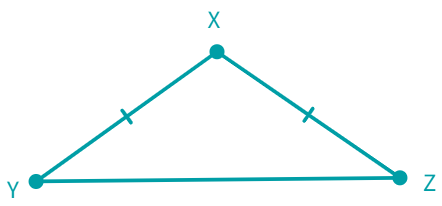Two Special Triangles : Equilateral and Isosceles
Activity One:
Drag out two copies of an equilateral triangle, say ABC. Place the second triangle on top of first traingle.Do both the copies align together perfectly?
Now, turn the copy around in any way. Do the triangles still remain perfectly aligned?
So, we can conclude that if the three sides of a triangle have equal lengths then the three angles are also of the same size.
So it can be said that, in an equilateral triangle:
(i) all sides have same length.
(ii) each angle has measure 60° ( = )
Activity Two:
Using paper, cut out an isosceles triangle, say XYZ such that XY = XZ. Now fold it so that the Z vertex lies on the Y vertex. The line, say XM through X, is called the axis of symmetry. And we also find that ∠Y and ∠Z fit on each other exactly.


Thus, in an isosceles triangle:
(i) two sides have same length (i.e. XY and XZ are called equal sides)
(ii) base angles opposite to the equal sides are equal (YZ is the base while ∠Y and ∠Z are the base angles which are also equal)
Therefore,
A triangle in which all the three sides are of equal lengths is called an
A triangle in which two sides are of equal lengths is called an
1. Find angle x in each figure:
a
Figure (i)
Solution:
Given angles:
Since the two base angles are
Thus, x = 40°.
b
Figure (ii)
Solution:
Given: One angle is 45° and the triangle is
The other base angle is also
x + 45° + 45° = 180°
x +
x = 180° - 90° =
Therefore, x = 90°
c
Figure (iii)
Solution:
Given: One angle is 50° and the triangle is
The other base angle is also
x + 50° + 50° = 180°
x +
x =
Therefore, x = 80°
d
Figure (iv)
Solution:
Given: Angles 100° , ∠x and the other ∠x.
Since the two angles are equal-
x + x + 100° = 180°
2x =
x =
Therefore, x = 40°
e
Figure (v)
Solution:
Given: Right angle 90°, ∠x and the other ∠x.
The sum of the angles in a triangle is
90° + x + x = 180°
90° +
2x =
x =
Therefore, x = 45°
f
Figure (vi)
Solution:
Given: Angle 40° and the other two angles x and x as the triangle is
The sum of the angles in a triangle is
x + x +
2x =
x =
Therefore, x = 70°
g
Figure (vii)
Solution:
Given: Angle 120° and the other two angles x and x (isosceles triangle).
The sum of the angles in a triangle is 180°
x + x +
2x =
x =
Therefore, x = 30°
h
Figure (viii)
Solution:
Given: Angle 110° and the other two angles x and x (isosceles triangle).
The sum of the angles in a triangle is 180°
x + x +
2x =
x =
Therefore, x = 35°
i
Figure (ix)
Solution:
Given: One exterior angle 30° which is equal to the sum of the two opposite interior angles.
The interior angles are x and x (isosceles triangle).
The sum of the angles in a triangle is 180°
x + x + (
2x +
2x =
x =
Therefore, x = 15°
